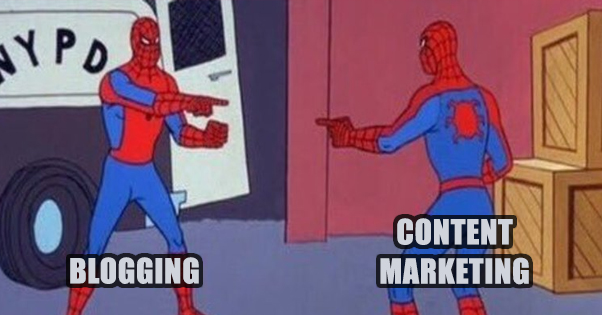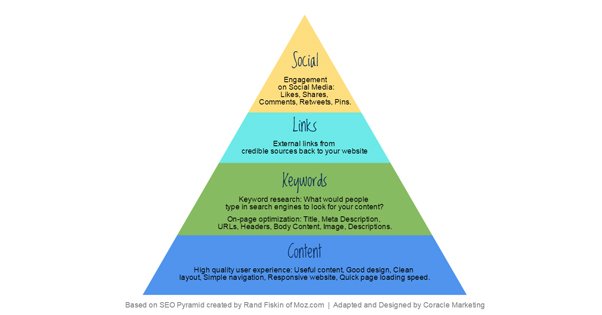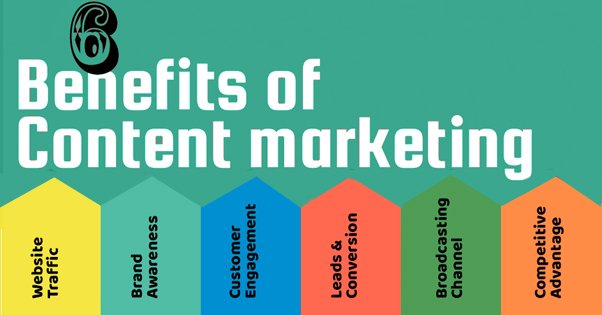Blogging vs. Content Marketing: What Is The Difference?
Published by Kenny Novak • Content Marketing • Posted June 29, 2019 ContentPowered.com
ContentPowered.com
I’m guilty of often referring to blogging and content marketing as interchangeable terms. I’ve used one when I’m talking about the other often enough. There’s a real difference between them, though, so it’s a topic worth talking about.
The Grand Pyramid
In a way, you can think of marketing as a sort of pyramid. At the top, at the peak, you have “marketing”. Marketing as a whole encompasses all below it on the flowchart. Marketing can be divided up into terms like inbound marketing and outbound marketing. One side encompasses SEO, the other covers things like TV and radio advertising.
When you follow the chain down, you eventually reach Content Marketing. Content Marketing is a sub-section of marketing that deals specifically with the production and distribution of content, typically online. We don’t usually think of it as “web content marketing” but that’s pretty much what it means.
Blogging, meanwhile, is further down within content marketing. You can think of blogging as one part of a whole content marketing plan. It’s similar to the way you can think of optimizing meta data as one part of a comprehensive SEO plan. That’s the primary difference between blogging and content marketing; content marketing encompasses a lot more than just a blog.
All About Blogging
Blogging is all about the act of writing blog posts for your blog on your website. Blog blog blog. It’s a repetitive word, right? Blog comes from “weblog” or web log, a sort of journal concept that sprang up on the internet around the same time the internet was forming.
Blogs started off as little more than personal journals kept by professionals deeply embedded in the web, the kinds of people who have always been at the forefront of technology, and also wanted to talk about it. By creating a blog, they could publish their thoughts without needing to deal with a traditional publisher.
Eventually, the idea of blogging was picked up by entrepreneurs looking to promote their business ideas, and then by businesses to promote themselves. Later, blogs started recruiting multiple authors. Well, that’s not quite true. As long as there have been businesses writing blogs, those blogs have had multiple authors. Often they were simply posting content as “blog admin” or as their business name, so you had no way to identify who wrote which piece of content.
These days, some websites have blogs written and maintained by a single person. Others are primarily maintained by one person, with sporadic additional contributions from other authors. Some have anywhere from 2-10 people writing for them on a regular basis. Others, like the largest blog sites ranging from Kotaku to VentureBeat to Forbes, have hundreds of contributors ranging from one-off writers to daily columnists.
Simply building and maintaining a blog on your website, with no other contributions to marketing, can dramatically increase brand trust and conversions. Neil Patel, a guru of blogging, found that just having a blog could increase conversions by up to six times.
It makes sense, right? When a company is producing content for their website, several things happen.
- Search engines find the content, and in so doing, are better able to show your website to people who will be interested in that content.
- People read the content. This allow you to build up a certain level of authority as a thought leader, or at the very least as someone who knows what they’re talking about. Insight and information build trust.
- People form a more favorable opinion of the company producing the content. Putting the effort out there, showcasing valuable information, teaching users; these all allow those users to form a positive opinion and in turn makes them more likely to convert.
This is all just from publishing content on your own website! Now, there are rules involved here. For example, you can’t just publish any sort of content you want. If you’re a brand selling athletic apparel, you probably don’t want to be blogging about auto repairs, about the latest astronomical discovery, or about the intricacies of forex trading. After all, if you get someone in the door thinking they’ll learn how to fix their car and you try to sell them shoes, they aren’t going to be happy about it.
Blogging at the most basic level is just writing content you want to write on a web domain you own. You can do this for personal blogs, for business blogs, for corporate blogs, for blogs focusing on political issues, and everything else. Blogging for marketing involves a bit more research and a bit more effort, but it’s still all about just writing content for your own site.
All About Content Marketing
So, where does blogging end and content marketing begin? It’s actually more difficult to answer that question than you might think.
Content marketing includes blogging, but it also includes other forms of related marketing that involves content. It’s not just the writing, but the research, the presentation, and the distribution of the content.
Blogging is the craft involved in producing content and publishing it on your site. Content marketing involves much more.
- Content marketing means figuring out the kinds of people you want to be reading your content.
- Content marketing means figuring out the kinds of content those people want to be reading.
- Content marketing means exploring forms of content publication beyond your own blog.
- Content marketing means reaching out to publish content in other locations.
The first point there is all about buyer personas. You strive to figure out the average sorts of people who make your ideal customers. For our hypothetical apparel shop, you have people who are athletic or who are looking to get into athletics, but you have a wide range of different personas within that category. You have people who like to run or cycle, you have people who are into sports, you have people who are into martial arts, and so on. You have to distill these concepts down to specific personas.
The second point is about topics, and can involve everything from reader polls to keyword research. When you have your personas on hand, you can then start to write content aimed at those people. For example:
- Your athletic cyclist customer persona will like to read articles about simple bike maintenance, reviews for cycling tools and gear, and apparel that can help make them more comfortable while riding.
- Your athletic sports customer persona will like to read about protective gear, about local sports leagues, and about historic moments in the sport.
Different people will like to read different kinds of content, but so long as that content falls under the general umbrella of “stuff your business is related to” you can get away with publishing it. Maybe your sports people don’t care about bike maintenance and your bike people don’t care about little league baseball, but as long as you cover both bases – no pun intended – you can attract both sets of customers to your store.
The third point means figuring out other forms that your content can take. There’s a lot there in terms of web media! You can write blog posts, but you can also write white papers and press releases for distribution to publications. You can write e-books for sale or for giving away in exchange for an opt-in. You can write email newsletters for subscribers. You can write posts for various social networks. You can even write scripts for audio and video content.
All of this is content marketing! Some people consider content marketing to stop at merely the written word, while others will consider anything produced to be informational as content, including videos, podcasts, slide decks, infographics, and webinars.
The fourth point is all about the outreach and the relationship building. When you guest blog for other websites, you build relationships with editors and fellow writers. When you send out press releases and white papers, you build relationships with marketers and reporters. When you release video content and post on social media, you build relationships with customers and potential partners.
All of this falls under the general heading of content marketing. There’s so much there to be explored beyond your own blog.
The Benefits of Content Marketing
Blogging on its own has plenty of benefits, as I’ve already mentioned. You build up the visibility to search engines, and the visibility to potential customers. You build up trust and a position as a thought leader. So what does content marketing bring to the scene?
Content marketing kicks all of the above into high gear. When you spend time creating your buyer personas, you know specifically the kinds of people who you will be bringing in, and thus exactly how you can reach them. You learn what kind of content performs best on the search engines, and how to produce more of it. You reach the specific audiences you want to reach, so you can entice them to visit your website and buy your products.
Studies show that today, the customer is leading the transaction. You aren’t throwing advertising at them and hoping they take you up on it; you’re putting yourself out there and asking for their time and attention. You’re marketing not through interruption, but through value. Your goal is not to drag the user into your orbit, but to entice them in with promises of Turkish delight.
Forming a Content Marketing Plan
More than just coming up with a list of topics to write about on your blog, a content marketing plan includes a wide range of types of content. How can you go about putting one together?
Step 1: Learn who you’re targeting. This is, again, the step where you’re creating buyer personas. A lot can go into this, and it’s definitely a broad enough topic for its own article. Thankfully, Hubspot has it covered with this template. This gives you a series of questions to ask about different possible personas to build them up.
Step 2: Figure out what problems the personas have that you can solve. For example, maybe you know that cyclists often encounter the problem of a flat tire on the road. You can provide a solution to this in two ways: you can write a piece of content about how to change a tire depending on the rim style and other variations, and you can sell them the new tubes, the tools, and anything else they may need. There you have an engaging possible piece of content by looking at the problems you can solve.
Step 3: Determine what makes you unique. Why should your readers trust your advice and buy your products instead of someone else? What is your unique value proposition?
Step 4: What kind of formats are you focusing on? Your apparel shop might not benefit from press releases, but you can create killer videos of athletic people in action using your products, so that sort of content works well. Figure out where it can be published as well, be it social media, guest blogs, partnerships, or your own site.
Step 5: Determine the mechanics. Mechanics include things like “how often should I be writing a new piece of content for X venue?” It also includes determinations of when you should narrow or broaden your focus, if you’re handling the SEO and other forms of marketing properly, and so on.
Once you’ve produced a content plan, then you can proceed with blogging as part of your total content marketing strategy.











